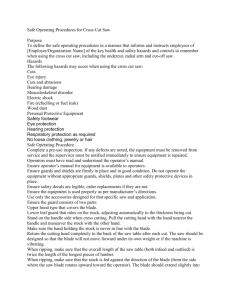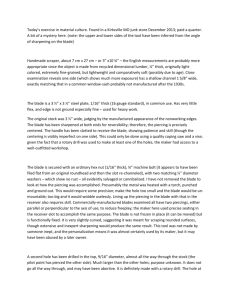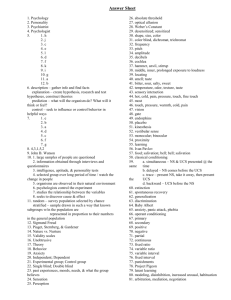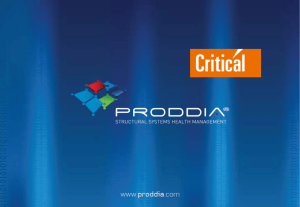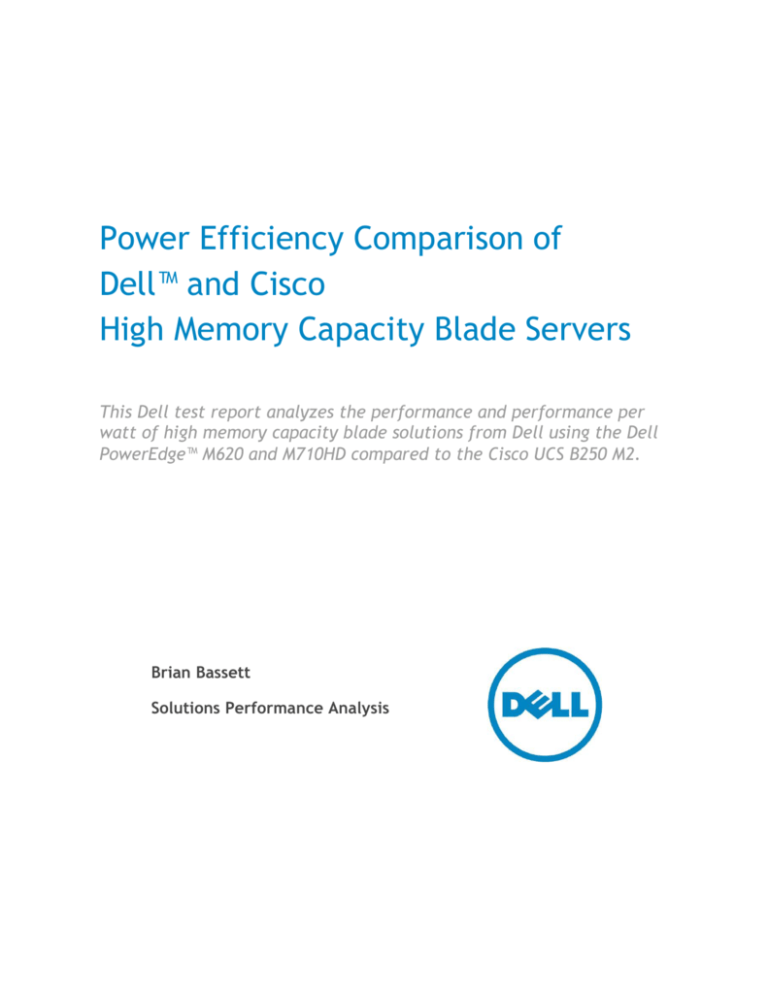
Power Efficiency Comparison of
Dell™ and Cisco
High Memory Capacity Blade Servers
This Dell test report analyzes the performance and performance per
watt of high memory capacity blade solutions from Dell using the Dell
PowerEdge™ M620 and M710HD compared to the Cisco UCS B250 M2.
Brian Bassett
Solutions Performance Analysis
Power Efficiency Comparison of Dell and Cisco High Memory Capacity Blade Servers
This document is for informational purposes only and may contain typographical errors and
technical inaccuracies. The content is provided as is, without express or implied warranties of any
kind.
© 2012 Dell Inc. All rights reserved. Dell and its affiliates cannot be responsible for errors or omissions
in typography or photography. Dell, the Dell logo, and PowerEdge are trademarks of Dell Inc. Intel and
Xeon are registered trademarks of Intel Corporation in the U.S. and other countries. Microsoft,
Windows, and Windows Server are either trademarks or registered trademarks of Microsoft Corporation
in the United States and/or other countries. Other trademarks and trade names may be used in this
document to refer to either the entities claiming the marks and names or their products. Dell
disclaims proprietary interest in the marks and names of others.
SPEC® and the benchmark name SPECpower_ssj® are registered trademarks of the Standard
Performance Evaluation Corporation. For more information about SPECpower, see
www.spec.org/power_ssj2008/
March 2012| Rev 1.0
ii
Power Efficiency Comparison of Dell and Cisco High Memory Capacity Blade Servers
Contents
Executive summary ..................................................................................................... 5
Introduction ............................................................................................................. 6
Methodology ............................................................................................................. 8
Comparison 1: Blade solution power efficiency with 1333 MHz memory ..................................... 8
Comparison 1 Summary .............................................................................................. 14
Comparison 2: Blade solution power efficiency at 1067 MHz memory speed .............................. 14
Comparison 2 Summary .............................................................................................. 16
Cost as tested ......................................................................................................... 16
Expandability .......................................................................................................... 16
Rack density ........................................................................................................... 17
Summary ............................................................................................................... 17
Appendix A—Test methodology .................................................................................... 18
SPECpower_ssj2008 standard .................................................................................... 18
BIOS settings ........................................................................................................ 18
OS tuning ............................................................................................................ 19
SPECpower_ssj2008 configuration .............................................................................. 20
Power meter configuration....................................................................................... 20
Appendix B—Server hardware configuration details ............................................................ 21
Appendix C—Server firmware and driver details ................................................................ 22
Appendix D—Comparison results ................................................................................... 23
Tables
Table 1.
Blade enclosure configuration details .................................................................. 6
Table 2.
Blade server details ....................................................................................... 7
Table 3.
Comparison 1 memory configuration ................................................................... 8
Table 4.
Comparison 2 memory configuration .................................................................. 14
Table 5.
Blade solution cost details .............................................................................. 16
Table 6.
Server hardware configuration details ................................................................ 21
Table 7.
Server firmware and driver details .................................................................... 22
iii
Power Efficiency Comparison of Dell and Cisco High Memory Capacity Blade Servers
Figures
Figure 1.
As seen in Comparison 1 Normalized Results ......................................................... 9
Figure 2.
Comparison 1 Normalized Results ....................................................................... 9
Figure 3.
Comparison 1 power utilization at 100% load ........................................................ 10
Figure 4.
Comparison 1 power utilization at idle ............................................................... 11
Figure 5.
Comparison 1 aggregate performance at 100% target load ....................................... 12
Figure 6.
Comparison 1 overall performance / watt scores ................................................... 13
Figure 7.
Comparison 2 normalized results ...................................................................... 15
Figure 8.
Comparison 1 results for UCS B250 M2 ................................................................ 23
Figure 9.
Comparison 1 results for PowerEdge M710HD ....................................................... 23
Figure 10.
Comparison 1 results for PowerEdge M620 ........................................................... 24
Figure 11.
Comparison 2 results for UCS B250 M2 ................................................................ 24
Figure 12.
Comparison 2 results for PowerEdge M710HD ....................................................... 25
Figure 13.
Comparison 2 results for PowerEdge M620 ........................................................... 25
4
Power Efficiency Comparison of Dell and Cisco High Memory Capacity Blade Servers
Executive summary
In March 2012, Dell Inc. commissioned its Solutions Performance Analysis team to compare the performance
and power efficiency of four-blade solutions using three choices of blades: the Cisco UCS B250 M2, Dell
PowerEdge M710HD, and the recently announced PowerEdge M620. To represent configurations common for
applications such as virtualization with heavy system memory requirements, each blade in all three solutions
had 192 GB of system memory installed.
Each solution had four blade servers, one blade enclosure with one I/O module and the maximum installable
power supplies, and one 10Gb top-of-rack switch.
Key findings
Performance / watt
The higher performance and lower power draw of the four-blade Dell solutions compared to the UCS B250 M2
blade solution led to the PowerEdge M710HD solution’s 76% higher performance per watt score and the
PowerEdge M620 solution’s 108% higher performance per watt score.
Power at Idle
Even with all blades configured with the same amount of system memory, the four-blade PowerEdge M710HD
solution consumed 58% as much power at idle as the four-blade UCS B250 M2 solution with its extra DIMMs
and supporting circuitry. Similarly, the four-blade PowerEdge M620 blade solution drew just 55% as much
power at idle as the Cisco blade solution.
Power at 100% Load
Both of the four-blade PowerEdge solutions, again with the same amount of system memory installed per
blade, drew 64% to 67% as much power as the four-blade Cisco UCS B250 M2 blade solution with all blades
running at 100% load.
Performance
With the same processor models and the same memory capacity installed in each blade, the four-blade solution
based on PowerEdge M710HD blades provided up to 11% higher performance than the four-blade solution
based on UCS B250 M2 blades, and the four-blade solution based on PowerEdge M620 blades provided up to
25% higher performance than the UCS blade solution.
Rack density
When the 10U M1000e Modular Blade Enclosure is equipped with its maximum of sixteen M710HD or M620
servers, the solution can fit 1.6 servers per rack unit of space, 2.4 times as dense as the solution with Cisco
UCS B250 M2 blades.
Cost
In the configuration tested, the Cisco UCS B250 M2 blade solution costs $112,591.02[1], while the similarly
configured Dell PowerEdge M710HD solution costs 34% less at $73,820.00 [2], and the PowerEdge M620
solution costs 33% less at $75,372.00[3].
[1]
Source: Quote from Cisco authorized reseller, February 22, 2012. Price is in U.S. dollars.
Source: Quote from www.dell.com, February 21, 2012. Price is in U.S. dollars.
[3]
Source: Quote from www.dell.com, February 21, 2012. Price is in U.S. dollars.
[2]
5
Power Efficiency Comparison of Dell and Cisco High Memory Capacity Blade Servers
Introduction
In order to compare the power efficiency of blade servers with high memory capacities installed, a Cisco blade
solution was assembled using four UCS B250 M2 blades (each with 192 GB of system memory installed) and
associated blade infrastructure. This solution was then measured for performance and performance / watt
using the industry-standard SPECpower_ssj2008 benchmark. For comparison purposes, a similar Dell blade
infrastructure was assembled and tested, first using four PowerEdge M710HD blades, and then using four
PowerEdge M620 blades. Each blade in the PowerEdge solutions also had 192 GB of system memory installed.
In all three cases, the entire blade infrastructure including the external network switch was included in the
power measurements.
The Cisco UCS 5108 Blade Server Chassis has eight blade slots, all of which are full with the four double-width
UCS B250 M2 blades installed. The Dell PowerEdge M1000e blade enclosure has sixteen blade slots, so with
four blade servers installed in the tested configurations, both Dell blade solutions have twelve slots open for
future expansion.
Table 1.
Chassis
Blade slots per chassis
Power supply quantity and
rating
I/O
External network switch
Management
Blade enclosure configuration details
Cisco UCS 5108 Blade
Server Chassis
8
4 x 2500W
1 x UCS 2104XP Fabric
Extender
UCS 6120XP 20-Port
Fabric Interconnect
Cisco UCS Manager
Dell PowerEdge M1000e Modular Blade Enclosure
16
6 x 2700W
1 x M8024-k 10GbE Switch Module
PowerConnect 8024F Switch
Dell CMC Module
As Table 1 shows, the infrastructure needed for the blade solutions was configured as similarly as possible
given the differences between the two blade enclosures. In the UCS setup, the external network switch hosts
the Cisco UCS Manager and is a required part of the solution, so in all three solutions, the external network
switch was included in power measurements.
6
Power Efficiency Comparison of Dell and Cisco High Memory Capacity Blade Servers
Table 2.
Blade server details
Blade Component
Cisco UCS B250 M2
Dell PowerEdge M710HD
Dell PowerEdge M620
Blade server form factor
Double-width
(consumes two chassis
slots
per blade)
Single-height
(consumes one chassis slot
per blade)
Single-height
(consumes one chassis slot
per blade)
Blades per solution
4
4
4
Empty chassis slots for
expansion
0
12
12
Processor sockets / blade
2
2
2
Processors / blade
2 x Intel Xeon X5675
(3.06 GHz)
2 x Intel Xeon X5675
(3.06 GHz)
2 x Intel E5-2660 (2.2
GHz)
Processor power (TDP)
95W
95W
95W
Physical / logical processor
cores / solution
48 / 96
48 / 96
64 / 128
Memory configuration / blade
48 x 4GB Dual Ranked
PC3L-10600R
LV RDIMMs
12 x 16GB Dual Ranked
PC3-12800R
LV RDIMMs
12 x 16GB Dual Ranked
PC3-12800R RDIMMs
Memory capacity / blade
192 GB
192 GB
192 GB
Installed memory / solution
768 GB
768 GB
768 GB
Hard Drives Per Blade
2 x 73GB 15k 6Gb
RAID 1
2 x 73GB 15k 6Gb
RAID 1
2 x 73GB 15k 6Gb
RAID 1
Storage Controller
LSI SAS30813E-R
Dell PERC H200
Dell PERC H310
Table 2 shows the configuration information for the four blades used in each blade solution. As with the blade
enclosures detailed in Table 1, the blades themselves were configured as closely as possible to each other
given the architectural differences.
The four blades (“nodes” in SPECpower_ssj2008 terminology) in each solution were each configured with two
95W processors, two 73GB hard drives, and dual 10Gb network ports installed. The Cisco B250 M2 blades with
Extended Memory Technology achieved their 192GB of system memory using forty-eight 4GB DIMMs each, while
the PowerEdge M710HD and M620 blades achieved the same memory capacity per blade using twelve 16GB
DIMMs each.
PowerEdge M620 blades used for the comparisons were equipped with 16GB standard voltage 1600 MHz DIMMs,
which are only available on systems with Intel Xeon E5-series processors. If the extra memory bandwidth
provided by 1600 MHz DIMMs is not needed, the M620 can be configured with 16 GB 1333 MHz low voltage
DIMMs like those used in the M710HD blades in the comparisons.
7
Power Efficiency Comparison of Dell and Cisco High Memory Capacity Blade Servers
In Comparison 1, which is detailed below, the memory in each blade was configured to run at 1333 MHz to
make the configurations as comparable as possible. For Comparison 2, each blade was configured with its
memory set to 1067 MHz and the test was run again to examine what differences this setting made to relative
performance and power efficiency of the three blade solutions.
Methodology
SPECpower_ssj2008 is an industry standard benchmark created by the Standard Performance Evaluation
Corporation (SPEC) to measure a server’s power and performance across multiple utilization levels. It should
be noted that Dell has published many results using this benchmark 4, while Cisco, at the time of writing, has
published none.5
Appendix A details the test methodology, Appendices B and C provide detailed configuration for the tests, and
Appendix D provides detailed report data that supports the results in this paper.
Comparison 1: Blade solution power efficiency with 1333 MHz
memory
In Comparison 1, the blades in all three solutions were configured with 192 GB of memory running at 1333 MHz.
The Cisco UCS B250 M2 was configured with all 48 DIMM slots occupied with 4GB low-voltage DIMMs. The
PowerEdge M710HD and M620 blades were configured with 12 DIMM slots occupied by 16GB DIMMs, so all blades
in the comparison had 192GB of memory installed.
In this comparison, the memory in the Cisco UCS C25 M2 blades was set to Performance Mode. This mode sets
the UCS B250 M2’s memory to run at 1333 MHz, but also disables Low Voltage memory operation and forces
system memory to run at 1.5 volts.
The memory in the PowerEdge M710HD blades was also set to 1333 MHz, but LV-DIMMs installed in the M710HD
can operate in low-voltage mode at that speed, so its memory was left at the default 1.35 volts. Finally, the
standard voltage memory in the PowerEdge M620 blades was set to run at 1333 MHz and 1.5 volts.
Memory configurations for Comparison 1 are summarized in Table 3 below.
Table 3.
Comparison 1 memory configuration
Comparison 1 memory config
Cisco UCS B250 M2
Dell PowerEdge M710HD
Dell PowerEdge M620
Memory configuration per
blade
48 x 4GB Dual Ranked
PC3L-10600R
LV RDIMMs
12 x 16GB Dual Ranked
PC3-12800R
LV RDIMMs
12 x 16GB Dual Ranked
PC3-12800R RDIMMs
Installed memory capacity
per blade
192 GB
192 GB
192 GB
Memory speed
(Actual / Max)
1333 / 1333 MHz
1333 / 1333 MHz
1333 / 1600 MHz
Memory voltage
1.5 V6
1.35 V
1.5 V
4
Dell SPECpower results at www.spec.org.
Cisco SPECpower results at www.spec.org.
6
When the memory subsystem in the B250 M2 blades is configured for Performance (1333 MHz) mode, the low
voltage DIMMs are forced to standard voltage mode (1.5 volts).
5
8
Power Efficiency Comparison of Dell and Cisco High Memory Capacity Blade Servers
Figure 1.
As seen in Comparison 1 Normalized Results
below, the Dell blade solutions have a distinct advantage over the Cisco blade solution in power draw both at
idle and at 100% target load, with the PowerEdge M620 solution drawing only 55% as much power as the Cisco
B250 M2 when both blade solutions were idle.
Compared to the four-blade UCS B250 M2 solution, aggregate performance at 100% target load was 10% higher
with the four-blade PowerEdge M710HD solution. The Cisco solution’s proprietary Extended Memory
Technology can have a negative impact on performance, as also seen with the UCS C250 M2 rack server7.
The performance of the PowerEdge M620 blade solution with 95-watt E5-series processors is even higher, with
an aggregate score 22% higher than of that of the UCS B250 M2 blade solution.
The higher performance of the PowerEdge M710HD and M620 solutions combined to give them a 75% and 104%
advantage, respectively, in overall performance per watt ratio compared to the UCS B250 M2 blade solution.
Figure 2.
Comparison 1 Normalized Results
Comparison 1: Blade solution power efficiency
with 1333 MHz memory
Power utilization, performance and performance/watt
2.2
2.04
2.0
The Dell blade solutions provide
up to 22% higher performance and
104% better power efficiency
1.8
1.75
Normalized Values
1.6
1.4
1.2
1.0
0.8
The Dell blade solutions draw less
power both at 100% load and at idle
1
1.22
1
0.67 0.64
0.6
1
1.10
1
0.58 0.55
0.4
0.2
0.0
Maximum power draw
(lower is better)
Cisco UCS B250 M2
7
Idle power draw
(lower is better)
Maximum performance
(higher is better)
Dell PowerEdge M710HD
Performance / watt
ratio
(higher is better)
Dell PowerEdge M620
Comparison of UCS C250 M2 and PowerEdge R710 rack servers.
9
Power Efficiency Comparison of Dell and Cisco High Memory Capacity Blade Servers
Figure 3 below shows the power utilization of each four-blade solution when running at 100% target load. The
Cisco solution draws 736 watts more than the M710HD solution, and 787 more watts than the M620 blade
solution, even though each of the three solutions have four similarly configured servers 8.
The UCS B250 M2 blade solution had higher power draw than both PowerEdge solutions at the 100% load level,
at idle, and all measured points between.
Figure 3.
Comparison 1 power utilization at 100% load
Comparison 1: Blade solution power draw
with 1333 MHz memory
Power utilization at 100% workload (lower is better)
2500
Average watts at 100% submeasurement
2,203
2000
1,467
1500
1,416
1000
500
0
Cisco UCS B250 M2
8
Dell PowerEdge M710HD
Dell PowerEdge M620
Required SPEC.org disclosure for Comparison 1:
The 4-node UCS B250 M2 solution scores (3,419,587 ssj_ops and 2,203 W) @ 100% target load for a
SPECpower_ssj2008 overall ssj_ops / watt of 1,006.
The 4-node PowerEdge M710HD achieved (3,749,443 ssj_ops and 1,467 W) @ 100% target load for a
SPECpower_ssj2008 overall ssj_ops / watt of 1,756.
The 4-node PowerEdge M620 achieved (4,175,133 ssj_ops and 1,416 W) @ 100% target load for a
SPECpower_ssj2008 overall ssj_ops / watt of 2,054.
10
Power Efficiency Comparison of Dell and Cisco High Memory Capacity Blade Servers
Figure 4 below shows each of the four-blade solutions’ power draw during the Active Idle phase of the
SPECpower_ssj2008 benchmark. The four-blade B250 M2 solution draws 478W more than the four-blade
M710HD solution and 517W more than the four-blade M620 solution.9
Figure 4.
Comparison 1 power utilization at idle
Comparison 1: Blade solution power draw
with 1333 MHz memory
Power utilization at idle (lower is better)
1200
1,151
Average watts at Active Idle
1000
800
673
634
600
400
200
0
Cisco UCS B250 M2
9
Dell PowerEdge M710HD
Dell PowerEdge M620
Required SPEC.org disclosure for Comparison 1:
The 4-node UCS B250 M2 solution scores (3,419,587 ssj_ops and 2,203 W) @ 100% target load for a
SPECpower_ssj2008 overall ssj_ops / watt of 1,006.
The 4-node PowerEdge M710HD achieved (3,749,443 ssj_ops and 1,467 W) @ 100% target load for a
SPECpower_ssj2008 overall ssj_ops / watt of 1,756.
The 4-node PowerEdge M620 achieved (4,175,133 ssj_ops and 1,416 W) @ 100% target load for a
SPECpower_ssj2008 overall ssj_ops / watt of 2,054.
11
Power Efficiency Comparison of Dell and Cisco High Memory Capacity Blade Servers
Figure 5 below shows each solution’s aggregate performance, computed by totaling the ssj_ops of each of that
solution’s four blades at the 100% target load level. The blade servers in the UCS B250 M2 and PowerEdge
M710HD solutions both use Intel Xeon model X5675 processors, and each blade of both solutions has 192GB of
system memory installed, but the M710HD solution’s aggregate performance is 10% higher in this comparison.
The UCS B250 M2 solution’s lower performance has also been measured on the Cisco UCS C250 M2 rack server,
and is further compounded by the inability through the UCS Manager to manually change a certain BIOS
parameter on the B250 M2 blades (see Appendix A).
The additional cores and greater per core efficiency of the E5-2660 processors used in the four-blade
PowerEdge M620 solution lead to its 22% higher aggregate performance than the four-blade UCS B250 M2
solution.10
Figure 5.
Comparison 1 aggregate performance at 100% target load
Comparison 1: Blade solution power
efficiency with 1333 MHz memory
Aggregate performance at 100% target load (higher is better)
4500000
ssj_ops at 100% submeasurement
4,175,133
4000000
3,749,443
3500000
3,419,587
3000000
Cisco UCS B250 M2
10
Dell PowerEdge M710HD
Dell PowerEdge M620
Required SPEC.org disclosure for Comparison 1:
The 4-node UCS B250 M2 solution scores (3,419,587 ssj_ops and 2,203 W) @ 100% target load for a
SPECpower_ssj2008 overall ssj_ops / watt of 1,006.
The 4-node PowerEdge M710HD achieved (3,749,443 ssj_ops and 1,467 W) @ 100% target load for a
SPECpower_ssj2008 overall ssj_ops / watt of 1,756.
The 4-node PowerEdge M620 achieved (4,175,133 ssj_ops and 1,416 W) @ 100% target load for a
SPECpower_ssj2008 overall ssj_ops / watt of 2,054.
12
Power Efficiency Comparison of Dell and Cisco High Memory Capacity Blade Servers
Figure 6 below shows the overall SPECpower_ssj2008 performance / watt scores of the three four-blade
solutions. The higher power draw of the Cisco solution with four B250 M2 blades, combined with that
solution’s lower aggregate performance, lead to an overall score of 1,006 ssj_ops / watt, compared to 1,756
ssj_ops / watt for the solution with four M710HD blade servers.
The difference is even greater when compared to the solution with four M620 blades with the higher
performing and more power efficient E5-2600 series processors. That solution achieved a score of 2054 ssj_ops
/ watt, or more than twice the score of the Cisco solution.
Figure 6.
Comparison 1 overall performance / watt scores
Comparison 1: Blade solution
performance/watt with 1333 MHz memory
Overall score comparison (higher is better)
SPECpower_ssj2008 overall ssj_ops per watt
2500
2,054
2000
1,756
1500
1000
1,006
500
0
Cisco UCS B250 M2
Dell PowerEdge M710HD
Dell PowerEdge M620
13
Power Efficiency Comparison of Dell and Cisco High Memory Capacity Blade Servers
Comparison 1 Summary
Cisco’s Extended Memory Technology is claimed to provide improvements to performance and power
efficiency. As shown with results of the SPECpower_ssj2008 benchmark, however, the solution with four UCS
B250 M2 blade servers provides lower aggregate performance and significantly higher power draw at all tested
load levels compared to the solution with four similarly-configured PowerEdge M710HD blade servers. These
factors combine to give the four-blade M710HD solution a 75% lower performance / watt ratio than the Cisco
solution in this comparison.
The solution based on four of the recently introduced M620 blades achieves an even greater performance and
power efficiency advantage, giving it more than twice the power efficiency score of the Cisco solution.
Comparison 2: Blade solution power efficiency at 1067 MHz memory
speed
The Cisco UCS B250 M2 blades are able to run LV-DIMMs at the low voltage 1.35 volt setting only when memory
is set to Power Saving Mode, which also runs all system memory at 1067 MHz. For Comparison 2 this mode was
selected for the UCS B250 M2 blades.
The PowerEdge M710HD can run low voltage DIMMs at 1.35 volts while keeping its system memory at 1333 MHz,
but in the interest of configuring the three solutions as closely as possible, for Comparison 2 the PowerEdge
M710HD also had its system memory set to 1067 MHz. The 1600 MHz DIMMs used in the PowerEdge M620 blade
solution run at 1.5 volts, and were also clocked down to 1067 MHz for Comparison 2.
Table 4.
Comparison 2 memory configuration
Comparison 2 memory config
Cisco UCS B250 M2
Dell PowerEdge M710HD
Dell PowerEdge M620
Memory configuration per
blade
48 x 4GB Dual Ranked
PC3L-10600R
LV RDIMMs
12 x 16GB Dual Ranked
PC3-12800R
LV RDIMMs
12 x 16GB Dual Ranked
PC3-12800R RDIMMs
Installed memory capacity
per blade
192 GB
192 GB
192 GB
Memory speed
(Actual / Max)
1067 / 1333 MHz
1067 / 1333 MHz
1067 / 1600 MHz
Tested memory voltage
1.35 V
1.35 V
1.5 V
14
Power Efficiency Comparison of Dell and Cisco High Memory Capacity Blade Servers
As Figure 7 shows, lowering all blades’ memory speed to 1067 MHz had a slightly negative impact to the
aggregate performance of all three blade solutions, and less than 2% impact to overall performance / watt
score. Running the blades in the UCS B250 M2 with their memory set to Power-saving mode does little to
improve their performance and power efficiency in this benchmark. When compared to the four-blade UCS
B250 M2 solution, the solution with four PowerEdge M710HD blades drew 67% as much power at 100% load and
58% as much power when both solutions were idle.
Similarly, the four-blade PowerEdge M620 solution had an even greater advantage, drawing 65% as much power
at 100% load and 55% as much power at idle compared to the UCS B250 M2 solution.
Figure 7.
Comparison 2 normalized results
Comparison 2: Extended Memory Technology
in Power Saving Mode
Power Utilization, Performance and Performance/Watt
2.2
2.08
2.0
The PowerEdge M620 solution
provides 25% higher aggregate
performance and 108% higher
power efficiency score
compared to the UCS B250 M2
solution
1.8
Normalized Values
1.6
1.4
1.2
1.0
0.8
Relative power draw for Comparison 2 is
similar to Comparison 1, with the M620
solution drawing 65% as much power as
the B250 M2 solution
1
1
0.67 0.65
0.6
1.76
1.25
1.11
1
1
0.58 0.55
0.4
0.2
0.0
Maximum power draw
(lower is better)
Cisco UCS B250 M2
Idle power draw
(lower is better)
Maximum performance
(higher is better)
Dell PowerEdge M710HD
Performance / watt
ratio
(higher is better)
Dell PowerEdge M620
15
Power Efficiency Comparison of Dell and Cisco High Memory Capacity Blade Servers
Comparison 2 Summary
Even with its system memory configured for Power Saving Mode, the four-blade UCS B250 M2 solution’s
combination of higher power draw and lower performance led to the four-blade PowerEdge M710HD solution
having a performance / watt ratio 76% higher, and the four-blade PowerEdge M620 solution having a
performance / watt ratio 108% higher.
Cost as tested
Cisco’s Extended Memory Technology is claimed to allow “large memory footprints … at a lower cost.”
However, in the configuration tested, the four-blade UCS B250 M2 solution with 192 GB of system memory per
blade costs $112,591.0211, while the comparably configured four-blade Dell PowerEdge M710HD with the 192GB
of system memory per blade costs over 34% less at $73,820.0012. Similarly, the four-blade PowerEdge M620
solution costs 33% less at $75,372.0013.
Table 5.
Blade solution cost details
Blade Infrastructure Cost
(Enclosure, PSUs, Internal and External
Network Switches)
Cost per blade
Cost for four blades
Total Cost of four-blade solution
(Infrastructure + blades)
PowerEdge Solution % Less
Blade solution cost details
UCS B250 M2
PowerEdge M710HD
PowerEdge
M620
$29,079.58
$25,444.00
$25,444.00
$20,877.86
$83,511.44
$12,094.00
$48,376.00
$12,482.00
$49,928.00
$112,591.02
$73,820.00
$75,372.00
--
34%
33%
Expandability
As noted earlier, the four B250 M2 servers used in the Cisco solution consume all eight slots in the UCS 5108
Blade Sever Chassis, leaving no room for future expansion without purchasing additional UCS blade chassis,
additional infrastructure like fabric extender modules and power distribution units, and consuming additional
ports in the top-of-rack switch.
As configured, each of the four-blade PowerEdge solutions used only four of the available sixteen slots in the
M1000e Modular Blade Enclosure, leaving twelve slots available for adding additional servers, without incurring
additional infrastructure costs.
11
12
13
Source: Quote from Cisco authorized reseller, February 21, 2012. Price is in U.S. Dollars.
Source: Quote from www.dell.com, February 21, 2012. Price is in U.S. Dollars.
Source: Quote from www.dell.com, February 21, 2012. Price is in U.S. Dollars.
16
Power Efficiency Comparison of Dell and Cisco High Memory Capacity Blade Servers
Rack density
The solution based on the UCS B250 M2 blade server can fit just four servers into the UCS 5108 Blade Server
Chassis, which consumes 6U (rack units) of rack space, or 0.67 servers per U. Thus, an admin could fit just 28
UCS B250 M2 servers in a standard 42U rack, assuming no space in that rack was consumed by infrastructure
like the UCS 6120XP Fabric Interconnect.
In contrast, when the 10U M1000e Modular Blade Enclosure is equipped with its maximum of sixteen M710HD or
M620 servers, the solution is 2.4 times as dense, able to fit 1.6 servers per U. With four M1000e enclosures
consuming 40U of rack space (leaving 2U for top-of-rack switches such as the PowerConnect 8024F used in this
test report), an admin could fit 64 M710HD or M620 servers in a single rack, with each server having the same
memory capacity, higher performance, and as much as 108% greater power efficiency compared to the UCS
B250 M2 blades.
Summary
The results of the testing contradict the claimed advantages of Cisco UCS Extended Memory Technology,
namely increased performance, reduced power, and lower cost. The four-blade Cisco UCS B250 M2 solution has
lower aggregate performance and worse power efficiency compared to the four-blade PowerEdge M710HD
solution with the same memory capacity per blade and the same model processors. In the tested
configurations, the PowerEdge M710HD blade solution costs 34% less than the comparably configured UCS B250
M2 solution.
The four-blade solution based on the recently introduced PowerEdge M620 blade is even better performing and
more power-efficient than both solutions, due in large part to Intel Xeon E5-2600 series processors. These
generational improvements lead to an even greater advantage for the M620 solution in aggregate performance
and power efficiency over the solution based on the UCS B250 M2. The PowerEdge M620 also has a 33% price
advantage over the comparable four-blade UCS solution, and both PowerEdge solutions are 2.4 times as rackdense as the UCS solution.
17
Power Efficiency Comparison of Dell and Cisco High Memory Capacity Blade Servers
Appendix A—Test methodology
SPECpower_ssj2008 standard
SPECpower_ssj2008 is an industry-standard benchmark created by the Standard Performance Evaluation
Corporation (SPEC) to measure a server’s power and performance across multiple utilization levels.
SPECpower_ssj2008 consists of a Server Side Java (SSJ) workload along with data collection and control
services. SPECpower_ssj2008 results portray the server’s performance in ssj_ops (server side Java operations
per second) divided by the power used in watts (ssj_ops/watt). SPEC created SPEcpower_ssj2008 for those
who want to accurately measure the power consumption of their server in relation to the performance that the
server is capable of achieving with ssj2008 workload.
SPECpower_ssj2008 consists of three main software components:
Server Side Java (SSJ) Workload—Java database that stresses the processors, caches and memory of
the system, as well as software elements such as OS elements and the Java implementation chosen
to run the benchmark.
Power and Temperature Daemon (PTDaemon)—Program that controls and reports the power
analyzer and temperature sensor data.
Control and Collect System (CCS)—Java program that coordinates the collection of all the data.
For more information on how SPECpower_ssj008 works, see http://www.spec.org/power_ssj2008/.
All results discussed in this test report are from “compliant runs” in SPEC terminology, which means that
although they have not been submitted to SPEC for review, Dell is allowed to disclose them for the purpose of
this study. All configuration details required to reproduce these results are listed in Appendices A, B, and C
and the first page of the result files from the runs compared are included in Appendix D. Full result files from
the runs compared are attached to this document for reference.
All servers were configured by installing a fresh copy of Microsoft ® Windows Server® 2008 Enterprise R2 (Service
Pack 1) with the operating system installed on a two-hard drive RAID 1 choosing the “full installation” option
for each.
The latest driver and firmware update packages available to both servers were installed at the beginning of
this study. Refer to Appendix B for details.
The Dell Solutions Performance Analysis Team ran SPECpower_ssj2008 three times per configuration and chose
the run with the highest overall ssj_ops/watt for each configuration to compare for this study.
BIOS settings
BIOS settings differed between the two manufacturers, so we tuned for best-known SPECpower_ssj2008
performance results.
For the Dell PowerEdge M710HD blade servers:
Turbo Mode Disabled in BIOS.
Adjacent Cache Line Prefetch Disabled in BIOS.
Hardware Prefetcher Disabled in BIOS.
DCU Streamer Prefetcher Disabled in BIOS.
Data Reuse Disabled in BIOS.
18
Power Efficiency Comparison of Dell and Cisco High Memory Capacity Blade Servers
DAPC Mode Enabled.
For the Dell PowerEdge M620 blade servers:
Turbo Boost Disabled in BIOS
Adjacent Cache Line Prefetch Disabled in BIOS.
Hardware Prefetcher Disabled in BIOS.
DCU Streamer Prefetcher Disabled in BIOS.
DCU IP Prefetcher Disabled in BIOS.
DAPC Mode Enabled.
Memory Patrol Scrub Disabled in BIOS.
For the Cisco UCS B250 M2 blade servers:
When managed through UCS Manager, the Cisco UCS B250 M2 blades do not allow directly changing values for
BIOS settings through the blades’ F2 setup; rather, the settings are controlled through profiles in the UCS
Manager interface.
Turbo Boost Disabled in profile.
Processor C3 Report set to enabled in profile.
Processor C6 Report set to enabled in profile.
CPU Performance set to the “Enterprise” template, which sets the following values on the blade BIOS:
o
Data Reuse Disabled
o
DCU Streamer Prefetcher Disabled
o
DCU IP Prefetcher Enabled
o
Hardware Prefetcher Disabled
o
Adjacent Line Prefetch Disabled
Most published results for SPECpower_ssj2008 from Dell and other vendors set the value of “DCU IP Prefetcher”
to “Disabled” when using Intel Xeon 5600-series processors. The lack of ability to set this value to Disabled
through UCS Manager likely hurt the aggregate performance scores of the UCS B250 M2 blades in this test
report.
For Comparison 1, the memory speed of all systems was set to 1333 MHz; for Comparison 2, the memory speed
of all systems was set to 1067 MHz.
OS tuning
To improve Java performance, large pages were enabled by entering Control Panel->Administrative Tools>Local Security Policy->Local Policies->User Rights Assignment->Lock Pages in Memory. The option was
changed to add Administrator.
Operating System Power Management mode for all solutions was changed to Power saver edited to turn off the
Hard Drive after 1 minute. On the Cisco UCS B250 M2 blades, which lack an integrated active power controller,
the setting “Minimum processor state” was changed to 0% from the default 5%, and the setting for “Maximum
processor state” was left at its default 100%. The PowerEdge M620 and M710HD blades did not need these
settings due to the integrated Dell Active Power Controller on those systems.
19
Power Efficiency Comparison of Dell and Cisco High Memory Capacity Blade Servers
We configured each server with a separate IP address on the same subnet as our SPECpower_ssj2008 controller
system where the Director, CCS, and PTDaemon components were located, and connected all servers to the
external network switch through NIC 1 for their respective runs.
SPECpower_ssj2008 configuration
IBM J9 Java Virtual Machine (JVM)14 was used for all solutions.
The following JVM options were used on both servers, as they are the best-known JVM tunings for
SPECpower_ssj2008 for the IBM J9 JVM when running with larger memory configurations:
-Xms1875m -Xmx1875m -Xmn1400m -Xaggressive -Xcompressedrefs -Xgcpolicy:gencon XlockReservation -Xnloa -XtlhPrefetch -Xlp
On each UCS B250 M2 and PowerEdge M710HD, with 24 logical processors per server, the following bindings
were used to ensure that each of the six JVMs ran on four logical processors:
start /affinity [F,F0,F00,F000,F0000,F0000]
On each PowerEdge M620, with 32 logical processors per server, the following bindings were used to ensure
that each of the eight JVMs ran on four logical processors:
start /affinity [F,F0,F00,F000,F0000,F0000,F00000,F000000]
Power meter configuration
We used the Yokogawa WT210 Digital Power Meter for the actual power measurement of the servers, as this is
the most commonly used analyzer for SPECpower_ssj2008 publications at the time that this study was
undertaken.
14
JVM build 2.4, J2RE 1.6.0 IBM J9 2.4 Windows Server® 2008 amd64-64 jvmwa64 60sr5-20090519_35743
20
Power Efficiency Comparison of Dell and Cisco High Memory Capacity Blade Servers
Appendix B—Server hardware configuration details
Table 6.
Server hardware configuration details
Dell PowerEdge M710HD
Dell PowerEdge M620
Cisco UCS B250 M2
Memory Modules
Total RAM in system
(GB)
Vendor and model
number
Type
Number of RAM
modules
Rank organization
192
192
192
Samsung M393B2G0AH0-YH9
Samsung M393B2G70BH0-CK0
Samsung M393B517FH0-YH9
PC3L-10600R
PC3-12800R
PC3L-10600R
12 x 16 GB
12 x 16 GB
48 x 4 GB
Dual Rank
Dual Rank
Dual Rank
Seagate
Seagate
Seagate
2
2
2
73
73
73
RPM
15,000
15,000
15,000
Type
SAS 6 Gbps
SAS 6 Gbps
SAS 6 Gbps
RAID Type
RAID 1
RAID 1
RAID 1
Controller
Dell PERC H200
Dell PERC H310
LSI SAS30813E-R
Hard Disk
Vendor and model
number
Number of disks in
system
Size (GB)
Operating System
Build number
Microsoft Windows Server®
2008 R2 Enterprise SP1
7601
Microsoft® Windows Server®
2008 R2 Enterprise SP1
7601
Microsoft® Windows Server®
2008 R2 Enterprise SP1
7601
File system
NTFS
NTFS
NTFS
Name
®
Network Adapter
Vendor and model
number
Type
Broadcom® 57712-k 10GbE 2P
Intel X520-k 10GbE 2P
Cisco UCS M81KR 10GbE 2P
Integrated
Integrated
Mezzanine card
21
Power Efficiency Comparison of Dell and Cisco High Memory Capacity Blade Servers
Appendix C—Server firmware and driver details
Table 7.
Server firmware and driver details
Driver/Firmware Versions
Dell PowerEdge M710HD
Dell PowerEdge M620
Cisco UCS B250 M2
System BIOS
Network Drivers
HBA Firmware
HBA Drivers
Video Driver
Integrated Management
Controller Firmware
4.1.0
16.4.0
07.03.05.00
2.0.35.10
1.1.3.0
1.0.2
2.9.67.0
20.10.1-0049
5.1.112.64
2.4.1.0
S5500.2.0.1d.081220111423
2.1.0.9
1.32.04.00
1.34.2.0
OS Native
3.33 Build 2
iDRAC7 1.00 build 70
2.0(1s)
22
Power Efficiency Comparison of Dell and Cisco High Memory Capacity Blade Servers
Appendix D—Comparison results
The first page of the SPECpower_ssj2008 results files which were generated for each server for convenience.
Full SPECpower_ssj2008 results files are attached to this document for reference.
Figure 8.
Figure 9.
Comparison 1 results for UCS B250 M2
Comparison 1 results for PowerEdge M710HD
23
Power Efficiency Comparison of Dell and Cisco High Memory Capacity Blade Servers
Figure 10.
Comparison 1 results for PowerEdge M620
Figure 11.
Comparison 2 results for UCS B250 M2
24
Power Efficiency Comparison of Dell and Cisco High Memory Capacity Blade Servers
Figure 12.
Figure 13.
Comparison 2 results for PowerEdge M710HD
Comparison 2 results for PowerEdge M620
25





